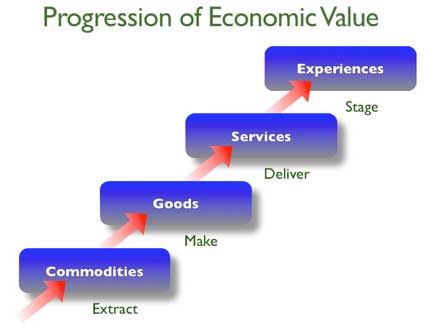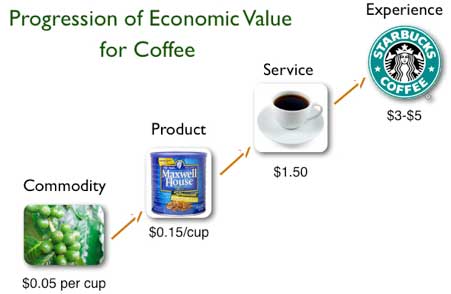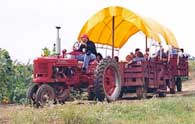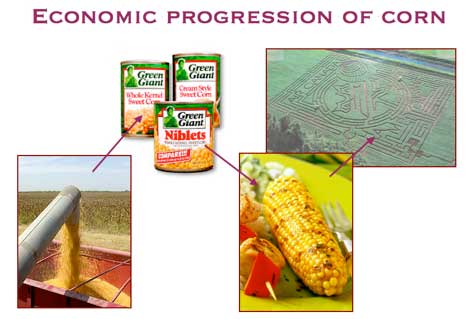Defining agritainment as the 4th Level of Economic Value
by Randy White
The greatest opportunity for farms that want to become agritainment or agri-tourism destinations is to move everything they offer to customers higher up on what is referred to as the progression of economic value. The four levels of economic value are:

Adapted from The Experience Economy: Work is Theatre & Every Business a Stage by Joe Pine and James Gilmore.
Economic activity and the progression of economic value start with raw commodities that are transformed into goods, which are then wrapped in services and finally transformed into experiences. Each level increases the total value to the customer, and accordingly, the total price the customer is willing to pay. Generally, price sensitivity decreases, profit margins increase and competition decreases as you move up the progression of economic value.
An illustration of this is coffee. Companies that harvest or trade coffee only get a dollar or two a pound. When a manufacturer grinds, packages, and sells those same beans to a grocery store, turning them into goods, the price to the consumer is $6 to $12 per pound, or about 10¢ to 25¢ a cup, depending on the brand and package size. Brew the coffee in a diner, and it sells for about $1.50 per cup. Businesses that envelop the purchase of the coffee in an experience such as a fine restaurant or Starbucks, get $3 to $5 a cup. At Starbucks, you’re paying not only for the java, but also for the Starbucks’ experience.

Interestingly, when you move a product up the progression of economic value to an experience, you rarely see discounting. Starbucks doesn’t need to offer discounts to generate business. Consumers just want their coffee drinks -- at what would have been considered an outrageous price only a few years ago.
Another example of the progression of economic value is birthday parties. Half a century ago, mothers made birthday cakes from scratch with butter, sugar, eggs, flour, milk, etc. Those commodities cost maybe fifty cents back then. Then in the 1960s and 1970s, along came cake mixes and canned frostings. These goods cost several dollars. Then in the 1980s, many parents stopped baking cakes and ordered custom cakes from the supermarket or local bakery, specifying the type of cake and frosting, designs or themes and the specific words for the top (a service). At $10 to $20, these cakes cost about 20 times what they cost to make at home and still involved only about a few dollar’s worth of ingredients (commodities). Then along came Chuck E. Cheese’s and other facilities that offered birthday parties. These facilities stage birthday party experiences that cost $150 and more per party.
Pick-your-own farms are turning commodities -- the produce -- into experiences by having the customer pick it (the experience), and thus commanding a premium price for the commodity versus its wholesale value. The vast majority of customers for u-pick, especially families with young children, don’t come to pick-your-own farms to save money by harvesting a commodity themselves. They come for the experience of both picking the produce as well as consuming produce that is local and fresh. This is not so different from the Starbucks formula, with the exception that at pick-your-own farms, the customer is doing some of the work. Strange as it may seem, when something is valued as an experience, customers will often pay more for it than its commodity or goods value, even while doing some of the work themselves.
Many commentators are referring to contemporary times as the experience economy (see the book The Experience Economy by Joe Pine and James Gilmore for a more detailed discussion on experiences).
Retailing is facing an increased challenge from the experience economy. One commentator has said:
“What is the problem? There are approximately one million shops in the U.S., and they are all selling basically the same stuff... Stores that sell products are an endangered species. Stores that sell values and experiences are poised for the future.”
Another factor fueling consumers’ desires for experiences and the growth of the experience economy is technology. The more virtual the world becomes, the more physical become people’s wants and needs. Far from being a substitute for the real world, cyberspace actually stimulates people’s desires for real-world, hands-on experiences.
John Naisbitt, author of High Tech, High Touch, has noted that the technology age has also created a boom for nostalgia, especially among Baby-Boomer parents. Nothing evokes nostalgia as much as the country farm and the opportunity to have a farm experience. Everyone has positive associations and images with the archetype of a famer.
Agritainment farms and agri-tourism destinations have many opportunities to move goods and services up the progression of economic value. This will not only differentiate the farms from the competition, but also increase their appeal by better meeting the needs and wants of market areas residents. The bottom line will be increased revenues and margins.
 One example is a hayride. It can be basically a service, providing transportation to the u-pick fields. Although the drivers may be dressed (costumed) as farmers, they don’t play the role or help stage an experience. A hayride can easily be elevated to an experience by having it narrated by a farmer who tells the story of the farm, agriculture in the area, how the crops are grown and even the history of a particular area on the farm. The hayride could pass by some fields with interesting farm animals, like draft horses or oxen. If it were strawberry season, the narration might include:
One example is a hayride. It can be basically a service, providing transportation to the u-pick fields. Although the drivers may be dressed (costumed) as farmers, they don’t play the role or help stage an experience. A hayride can easily be elevated to an experience by having it narrated by a farmer who tells the story of the farm, agriculture in the area, how the crops are grown and even the history of a particular area on the farm. The hayride could pass by some fields with interesting farm animals, like draft horses or oxen. If it were strawberry season, the narration might include:
How do you recognize ripe strawberries? How do you pick them? Where did strawberries originally come from? What makes our strawberries different from the ones in the supermarket? How many pints of strawberries will an acre produce? How long will it take a new strawberry plant to have fruit? Did the Indians harvest or grow strawberries? Did George Washington like strawberries?
This would elevate the hayride to a more memorable experience, increasing its value to the guest and differentiating the farm even further from its more commodity-oriented u-pick competition. Adding education content to leisure activities also increases their appeal to customers.
An example of elevating products in a farm market to experiences is the sale of food and beverages. In the store, bakery items, other foods and produce are only products. When there is an outside barbecue, an element of theatre is added. When there is a wheelbarrow loaded with fresh picked corn sitting next to the grill, the corn is being roasted in the husk on the grill and customers are shucking and eating the corn, it suddenly becomes an experience. The ear of corn that might sell for 25¢ as produce suddenly sells for $2 as an experience. Not only is the economic value of the grilled corn higher, but also the eating experience enhances the perceived value of the other ears of corn sold by the dozen to take home. And the guest is getting an experience that supermarkets or produce stands can’t offer. When the grill-master is dressed like a farmer and talks about the corn, how it is raised, the variety, etc., the experience becomes even more appealing, as an edutainment component is added.
Take the process one step further. Take a narrated hayride to some corn fields where you pick your own corn, bring it back and have some grilled before your very eyes, which you then shuck and eat (of course you will buy a drink, sandwich and potato salad to go with it, as well as finish off the meal with some ice cream). Many similar experiences of theatre and education can be created with other produce.
How about making your own s’mores outdoors over a campfire? Suddenly some products that would sell for only maybe 25¢ are suddenly worth $2 as part of an experience that includes nostalgic memories for parents who want their children to have that experience.
Display cooking/preparation of orders at a farm restaurant elevates the perceived value of the food higher than a pre-wrapped sandwich. There is theatre, as you are watching your custom order being prepared. Seeing it made means it is fresh. Even the Subway store makes fresh sandwiches in full view.
Demonstrations of brand products in a farm market are another way to turn products into experiences. This can be anything from baking demonstrations to fruit carving to 20 things to do with your strawberries. Offering cooking classes at non-peak times adds educational experiences.
Changing a farm market from a place you go to buy products to experiential retail -- a place you go to have experiences (and possibly learn at the same time) will greatly increase traffic, sales, margins and profits. What’s more, it will make the store even more of a preferred destination in its trade area.
Direct-to-market and agritainment, whether pick-your-own, a farm store, a corn maze, pumpkin patch or a Halloween fall festival, have great potential to be moved up the progression of economic value not only to enhance the appeal, but also revenues and profit margins. No one has ever topped how farmers turned the progression of economic value on its head with corn mazes, where a commodity is turned into an experience that you charge for, and then at the end of the season, the corn is still harvested as a commodity.

With the public’s increasing desire for quality leisure experiences -- especially authentic and nostalgic ones -- direct-to-market and agritainment have a great future for those farmers who understand how to move their offerings up to the highest possible level of the progression of economic value.
Randy White is the CEO of the 21-year-old White Hutchinson Leisure & Learning Group. The company assists agritainment facilities with feasibility, master planning, design and consulting on operations. Randy is recognized as one of North America’s top agritainment experts and has worked for some of the country’s most successful agritainment businesses. The company is responsible for the development of the first children’s discovery farm at Davis’ Farmland. Randy can be reached at, +1.816.931-1040, ext 100 or via the company’s website.


